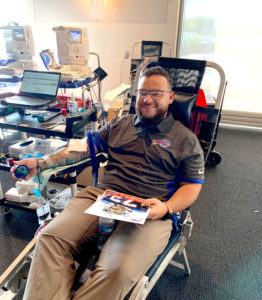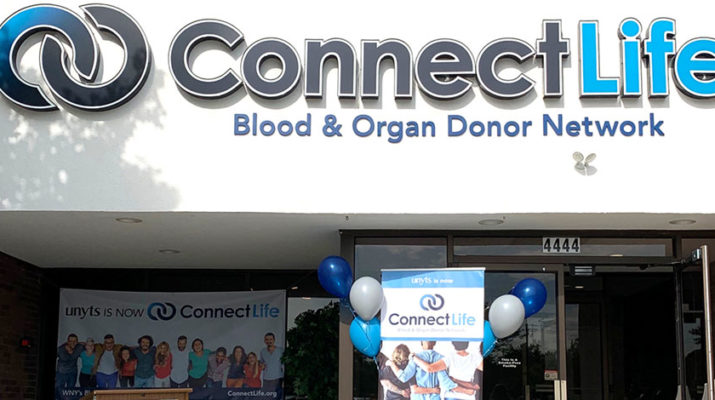Blood and organ donation nonprofit changes name to better reflect mission. ‘Service to others is the founding tenet of ConnectLife,’ says official
By Jana Eisenberg

You may have heard of UNYTS and known that it had something to do with blood drives and blood donations, but been unaware of all the other services and elements that are involved in the nonprofit’s work.
If so, you wouldn’t be alone.
After two years of research into that very topic, the leadership at UNYTS —or Upstate New York Transplant Services — came to the realization that it needed to better define and explain itself to continue its literally life-saving work.
The new name, ConnectLife, introduced this summer, is meant to simply and clearly convey what they do: in a nutshell the organization “helps people help others.”
In addition to being a federally designated organ, eye, and tissue procurement agency, ConnectLife is Western New York’s only community blood center.
That means that rather than being shipped out of the area, all of the blood collected by ConnectLife stays local.
This helps most area hospitals in Western New York’s eight counties, both in terms of maintaining inventory and in savings on out-of-state sourcing costs. Every pint of donated blood can help up to three people.
ConnectLife’s new vision statement is a good starting place for describing how the organization works, and the things it does: “ConnectLife envisions a future where blood is available for all in need, we decrease the number of deaths of those waiting for a transplant, innovative tissues enhance the quality of life and advance cutting-edge research, every donor and donor family is honored, and employees are empowered and motivated to realize their highest potential in service of our mission.”
In other words, ConnectLife’s most important goals are the combination of collecting blood donations and securing eye, tissue, and organ donors, and then making sure that the people who need those things, get them, all done respectfully and with efficiency, clear communication and gratitude.
The act of donating one person’s organs can help save up to eight lives, and one tissue donor can help up to 75 people.
In Western New York, according to ConnectLife, there are close to 1,000 people of all ages waiting for an organ transplant. Nationally, it’s estimated that more than 20 people die every day waiting for an organ. So, the need is great.
“Service to others is the founding tenet of ConnectLife,” said Sarah R. Diina, the director of marketing and community development. “We work to make the blood donation process as personal and painless as possible. And, during very emotional times, we strive to help the families of organ, eye, and tissue donors honor the wishes of their loved ones.”
ConnectLife works closely with those families, often with very compelling results. “Eye, organ and tissue donation is a very personal decision,” Diina continued. “And our incredible donor families usually end up becoming advocates for donation as well. They’re so happy to give back — after the experience of losing a loved one, in one of the worst moments of their lives, they have the knowledge that their loved one was able to go on and help others live. Especially those who lose a child — to know that their daughter’s heart, or their son’s lungs are helping someone else breathe and live…It can help them get through the horrible trauma. The families stay connected with us for years; they attend our events, speak with new donors, and continue to make those connections.”
These connections, so intimate and profound, reflect and support ConnectLife’s conviction that Western New Yorkers — even more than most Americans — have the inherent desire to do good.
“The percentage of consent to donating among the WNY community is close to 80%; that’s higher than the rest of the country. People here are so giving, and want to help their neighbors,” said Diina.
Education is also an important element. ConnectLife works closely with schools to create the next generation of donors, giving them the information they need to make lifesaving decisions.
“We have an incredible program that runs throughout the school year that works with close to 80 area schools,” said Diina. “The club teaches students about both the clinical end — like blood, organ eye and blood donation — and also about healthcare careers. Through their club activities, like organizing year-end school or community blood drives and campaigns to register organ donors, they gain leadership skills. Kids can be more open to discussing things like organ and blood donation; many of them become blood donors for life. They also become amazing advocates.”
“We also spend time educating the general public and our clinical partners about how to talk about organ and tissue donation,” added Diina. “It’s important to understand the breadth of the decision and the process. Fear can be a factor in taking that step to register as a donor. We help potential donors to talk with their families as well.”
If there is an objection on religious grounds, ConnectLife has advocates from a wide range of faiths to talk with families; most faiths, said Diina, see donation as an act of charity, and none specifically forbid it. “We’ve come up against this in the hospital; if someone has registered as a donor but a family might be pushing back,” she said. “We have a great group of clergy who help navigate these situations, and we can usually come to some sort of understanding to both honor the wishes of donors while making sure the family is comfortable.”
Tissue donation is another important area. It’s used both immediately, in a wide variety of surgical applications, like burn victims. It’s also vital for research. “We’re part of the National Disease Research Interchange,” said Diina. “When families consent, donated tissue has been used for things like autism or HIV research, and at Roswell on specific projects related to cancer.”
ConnectLife also endeavors to dispel the many myths and misconceptions that surround organ, eye and tissue donation. Updated, positive and respectful language has been approved by the Donor Family Council of the Association of Organ Procurement Organizations, and is also supported by the American Society of Transplantation and American Society of Transplant Surgeons. The approved language replaces old-fashioned or ghoulish phrases, i.e. old: “harvesting” organs vs. new: “recovery” or “donation” of organs; old: “cadaver” vs. new: “deceased donor,” etc.
“When someone who has registered as a donor is in the hospital, nearing their end of life, the hospital and staff are all working as hard as they can to save that person’s life,” explained Diina. “The hospital personnel do not know if the person is a donor; they don’t have access to the registry. Only after a person is pronounced deceased are we called in.”
“ConnectLife is an amazing place to work and be a part of,” said Diina. “We are saving and enhancing lives; we hear positive stories from donors, donor families, organ and blood recipients — we’re having an impact on people’s lives now, and also impacting lives that will be saved through eye, organ, blood and tissue donation.”
For more information about the organization, visit www.connectlife.org or call 716-529-4300.
Photo: Headquarter of ConnectLife at 4444 Bryant and Stratton Way, Williamsville. The organization was known as UNYTS until it changed its name over the summer. Photo courtesy of ConnectLife.

